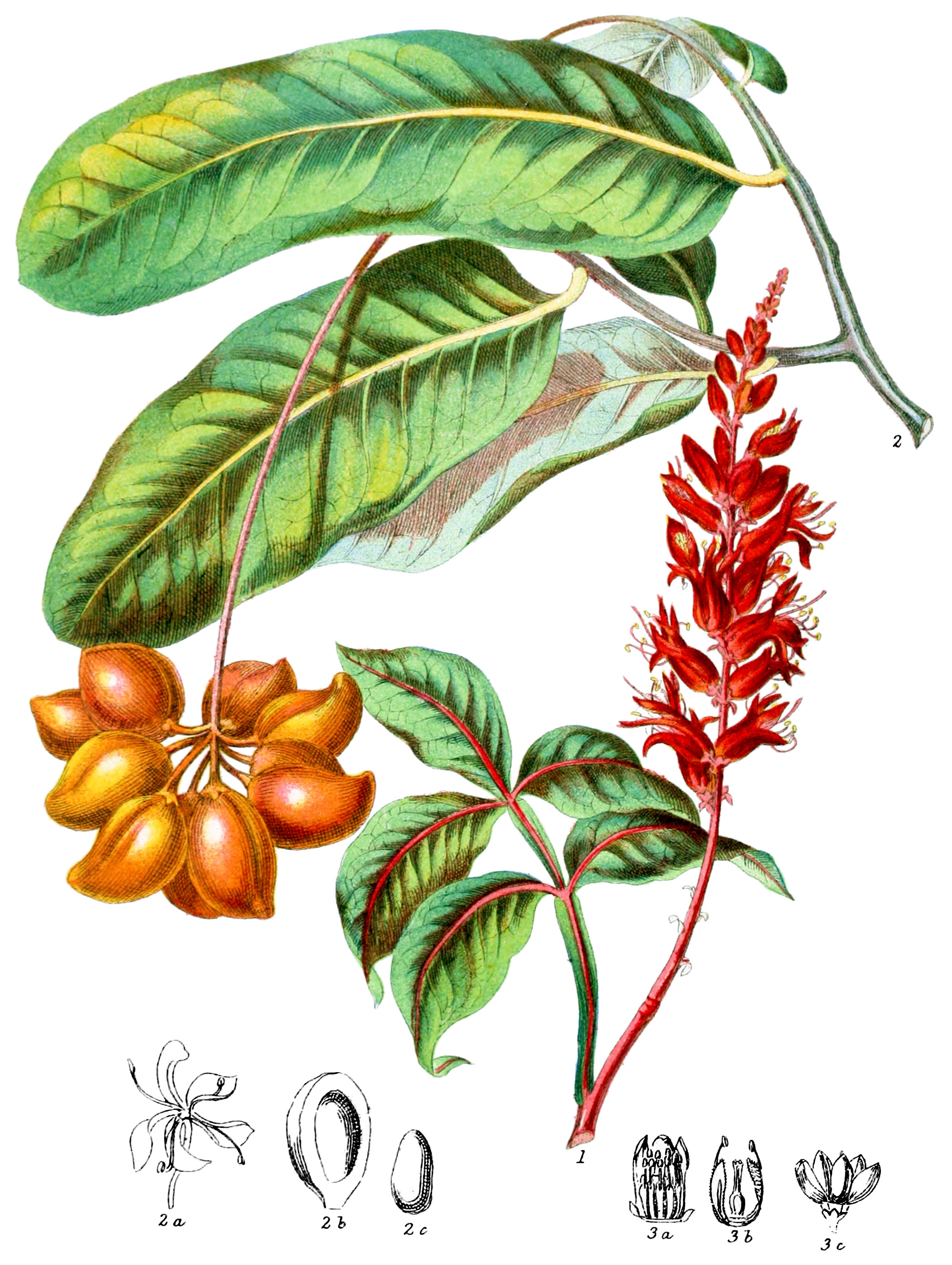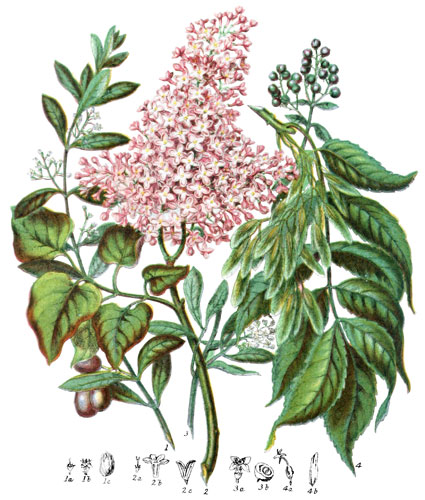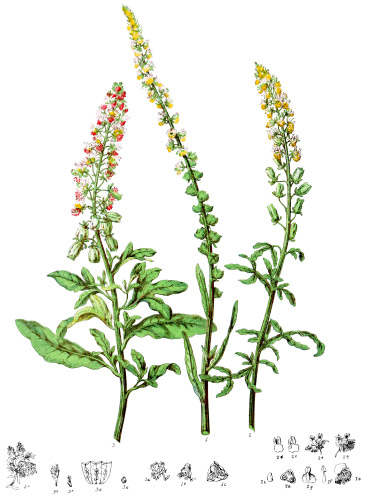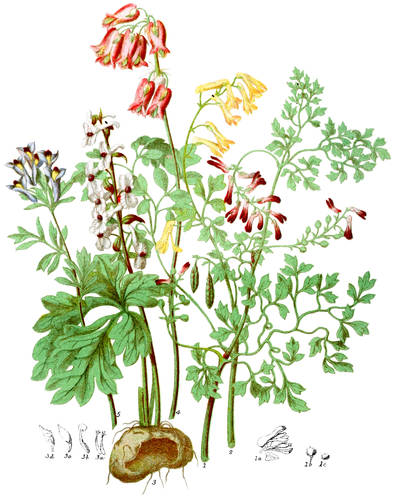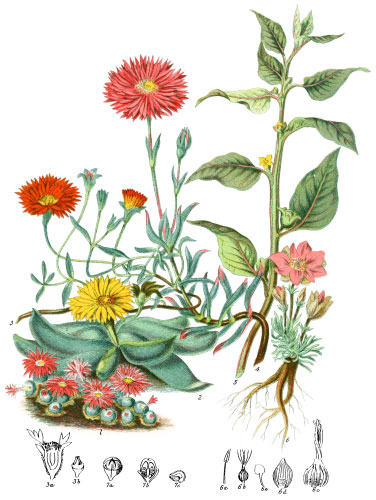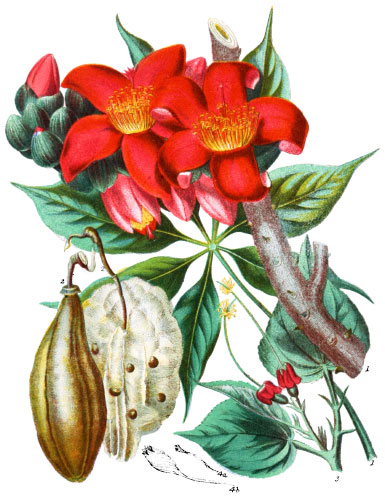Key characteristics
Trees and shrubs; the leaves are alternate, usually compound, occasionally simple, without dots. The flowers are at the end of the branches, or grow from the base of the leaf-stalk; the petals are green, whitish, or red; the stamens and pistils are sometimes in separate flowers. The calyx is small, thick, parted into four or five divisions at the top; the petals are of the same number, much longer than the calyx, generally combined into a tube at the base, spreading or twisted; usually of a greenish hue, white or red. The stamens are usually ten, each arising from the back of a hairy scale growing at the base of the pistil, five generally losing their anthers before the rest. The ovary is four or five lobed, placed on a stalk, from the base of which the stamens arise; it has four or five cells, each cell containing one ovule; the style is simple, the stigma occasionally four or five lobed. The fruit consists of four or five drupes arranged around a common receptacle, not gaping when ripe. The seeds are pendulous, with a membranous covering and contain no albumen.
These plants have affinity with the Rue tribe, but may be readily distinguished by the want of dots in the leaves, and by the seed-vessels remaining closed.
An intense bitterness in all the parts is their chief characteristic.
Select plants in this order
Not all plants listed are illustrated and not all plants illustrated are listed.
- The name Quassia was adopted from that of the Indian who first discovered the bitter qualities of these plants, and employed them successfully as a remedy in the fevers of Surinam.
- Simaruba officinalis (1), or Quassia amara, as it was formerly called, is a shrub ten feet high, with grey bark, of beautiful appearance when covered with its spikes of red flowers. It possesses the bitter property in an excessive degree, especially in the root, but combined with other qualities that are now supposed to render it injurious as medicine. Small cylindrical chips of the white root were at one period imported in considerable quantities from Surinam; of late years the traffic has diminished. An infusion of the flowers is still taken by the natives medicinally. The chief use of Quassia in this country is as a poison for flies and other insects; also as an illegal substitute for hops in making beer.
- Some botanical travellers have supposed the Quassia chips are obtained from Picræna* excelsa; that, however appears to be of inferior quality.
- S. amara is frequently used as medicine in the West Indies; the natives of Cayenne take a decoction of the bark as a common remedy in fever; the wood has the same properties, but less powerful; it is described by Sir Robert Schomburgk as similar to the White Pine.
- S. versicolor, called Paraiba by the Brazilians, is so exceedingly bitter that it is secure from the attacks of insects, not only in a fresh state but even when dried in an herbarium. This bitter principle in plants appears to be one of the most perfectly retained, as may be observed in the common British Wormwood, on breaking or lightly moving portions of this herb after having been preserved in a dry state for many months, the minute particles ascend directly, and will be perceived in their full bitterness of flavour on the lips. It is said that the wood of this tribe is unfit for burning on account of the air becoming impregnated with a bitter smoke, and travellers have related that food cooked at a fire made of such fuel is unwholesome.
- Samadera indica (2), the Kroon-nooten of the Dutch traveller and naturalist, Van Rheede, affords the Niepa bark used by Indians as a febrifuge. The name is very descriptive of the growth of the cluster of fruit. The wood is white and bitter, as usual in this tribe; the bark black; the stem reaches about thirty-five feet in height. The petals are red above, yellow or white beneath. Each fruit contains one nut; the pulp is extremely bitter, and is considered good as medicine, although not as food.
- Nima quassioides is well known in northern India for its medicinal properties.
- Simaba (3), Brucea, and Sumatrana, in their qualities resemble Quassia.
Locations
The Tropics of Asia, Africa, and America, are the regions favourable to this Tribe; Nima belongs to the Himalayas.
Legend
- Simaruba officinalis, Bitter Quassia. Guiana.
- Samadera indica, Indian Crown-Nut. Sandy Shores of Malabar and Ceylon.
- Flower.
- Fuit.
- Nut.
-
- Simaba guianensis. Stamens and three of the Petals. Guiana.
- Pistil and two Stamens.
- Seed-vessels.
*Picræna was spelled as “Picrœna” in the original description.
Explore more
Posters
Decorate your walls with colorful detailed posters based on Elizabeth Twining’s beautiful two-volume set from 1868.
Puzzles
Challenge yourself or someone else to assemble a puzzle of all 160 botanical illustrations.
